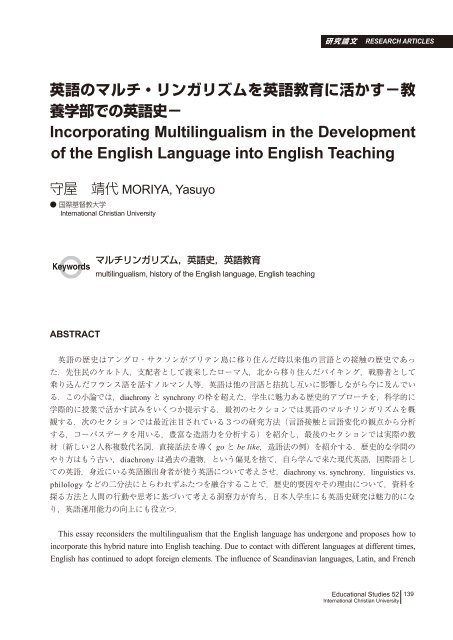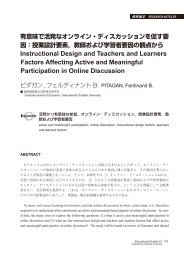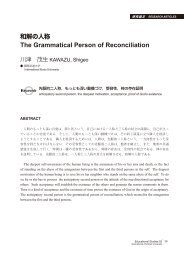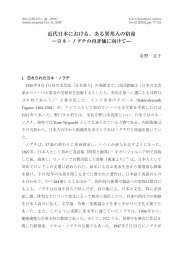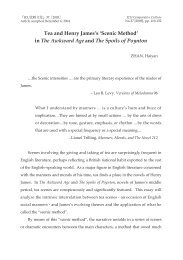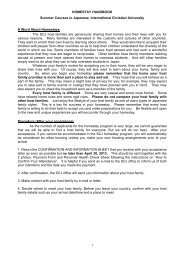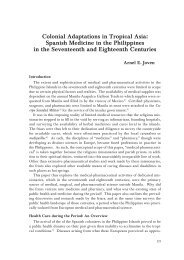Incorporating Multilingualism in the Development of the English ...
Incorporating Multilingualism in the Development of the English ...
Incorporating Multilingualism in the Development of the English ...
Create successful ePaper yourself
Turn your PDF publications into a flip-book with our unique Google optimized e-Paper software.
is well known, but o<strong>the</strong>r languages have brought a significant number <strong>of</strong> varieties <strong>of</strong> words, mean<strong>in</strong>gs and evennew phonemes. After review<strong>in</strong>g multil<strong>in</strong>gualism <strong>of</strong> <strong>the</strong> <strong>English</strong> language, <strong>the</strong> essay <strong>in</strong>troduces three recentapproaches reflect<strong>in</strong>g diachronic studies: language contact, corpus, and word formation rules. F<strong>in</strong>ally, <strong>the</strong> essay<strong>in</strong>troduces teach<strong>in</strong>g materials that help students understand how <strong>English</strong> had contact with o<strong>the</strong>r languages andborrowed various l<strong>in</strong>guistic particulars from <strong>the</strong>m. The materials <strong>in</strong>clude exercises and field work tasks on newvarieties <strong>of</strong> <strong>the</strong> second person plural pronoun, new report<strong>in</strong>g verbs, and <strong>the</strong> powerful word formation rules. Thefirst-hand experience <strong>of</strong> observ<strong>in</strong>g synchronic varieties and diachronic changes helps students acquire reason<strong>in</strong>gskills to expla<strong>in</strong> special l<strong>in</strong>guistic phenomena and realize <strong>the</strong> importance <strong>of</strong> <strong>the</strong> actual context.Be<strong>in</strong>g a faculty member who teaches <strong>the</strong> history<strong>of</strong> <strong>the</strong> <strong>English</strong> language, I <strong>of</strong>ten encounter withsomewhat negative comments from my students aswell as from my colleagues such as, “The study <strong>of</strong><strong>the</strong> history <strong>of</strong> <strong>the</strong> <strong>English</strong> language is now outdated,”“The synchronic approach first proposed by deSaussure more than a hundred years ago and adoptedby modern l<strong>in</strong>guists is superior to <strong>the</strong> diachronicapproach,” and “Study<strong>in</strong>g historical l<strong>in</strong>guistics islike stay<strong>in</strong>g <strong>in</strong> <strong>the</strong> dark part <strong>of</strong> <strong>the</strong> library surroundedby old books and dusty dictionaries.” Despite<strong>the</strong>se stereotypical ideas, I believe that hav<strong>in</strong>g <strong>the</strong>knowledge on multil<strong>in</strong>gualism and language contactthat <strong>English</strong> has been experienc<strong>in</strong>g is beneficialto EFL students. This essay suggests how <strong>English</strong>teachers may be able to <strong>in</strong>corporate multil<strong>in</strong>gualismthat <strong>the</strong> <strong>English</strong> language has had from its birth andhow such materials can help students understand <strong>the</strong>complex structure <strong>of</strong> <strong>the</strong> <strong>English</strong> language and itshybrid nature due to <strong>the</strong> contact with o<strong>the</strong>r languages.Be<strong>in</strong>g affected by <strong>the</strong> contact with differentlanguages at different times, <strong>English</strong> has cont<strong>in</strong>uedand is still cont<strong>in</strong>u<strong>in</strong>g to adopt foreign elements.The <strong>in</strong>fluence <strong>of</strong> Scand<strong>in</strong>avian languages, Lat<strong>in</strong>,and French is well known, but o<strong>the</strong>r languages havebrought about a significant number <strong>of</strong> new words,new mean<strong>in</strong>gs and even new phonemes. Br<strong>in</strong>tonand Arnovick summarize <strong>the</strong> percentages <strong>of</strong> <strong>the</strong>etymological sources <strong>of</strong> <strong>the</strong> <strong>English</strong> lexicon asfollows:Table 1: The proportion <strong>of</strong> native and foreign elements <strong>in</strong> <strong>the</strong> <strong>English</strong> word stockSOED(80,096 words)ALD(27,241 words)GSL(3,984 words)West Germanic 22.20% 27.43% 47.08%French 28.37% 35.89% 38.00%Lat<strong>in</strong> 28.29% 22.05% 9.59%Greek 5.32% 1.59% 0.25%O<strong>the</strong>r Romance 1.86% 1.60% 0.20%Celtic 0.34% 0.25% –SOED (Shorter Oxford <strong>English</strong> Dictionary); ALD (Advanced Learners’ Dictionary); GSL(General Service List)(Br<strong>in</strong>ton & Arnovick, p.298)Even <strong>in</strong> <strong>the</strong> daily vocabulary, more than half <strong>of</strong><strong>the</strong> <strong>English</strong> vocabulary comes from foreign sources.Now <strong>English</strong> is adapted <strong>in</strong> various regions andused as a dom<strong>in</strong>ant communication tool around <strong>the</strong>140Educational Studies 52International Christian University
globe. Buck <strong>in</strong> an article entitled, “Why? and how?:Teach<strong>in</strong>g <strong>the</strong> history <strong>of</strong> <strong>the</strong> <strong>English</strong> language <strong>in</strong> ournew millennium,” asserts that “<strong>the</strong> history <strong>of</strong> <strong>the</strong><strong>English</strong> language is actually an <strong>in</strong>terdiscipl<strong>in</strong>aryfield ra<strong>the</strong>r than one that is narrowly def<strong>in</strong>ed.”Görlach <strong>of</strong>fers a concise explanation on <strong>the</strong> historicaldevelopment <strong>of</strong> <strong>the</strong> <strong>English</strong> language as follows:In a historical perspective, <strong>in</strong>dividual periods<strong>of</strong>fer <strong>the</strong>mselves for <strong>in</strong>vestigations <strong>of</strong> differentsubsystems <strong>of</strong> a language-for <strong>in</strong>stance, OE[Old <strong>English</strong>] for <strong>the</strong> functions <strong>of</strong> <strong>in</strong>flectionsand ME [Middle <strong>English</strong>] for its gradual loss,<strong>the</strong> massive borrow<strong>in</strong>g from many languagesand <strong>the</strong> consequences <strong>of</strong> this process, as wellas regional, social and stylistic diversity andmultil<strong>in</strong>gualism. (2001, p. 47)The multil<strong>in</strong>gual nature has made <strong>the</strong> language<strong>in</strong>tricately complex, but <strong>English</strong> teachers havetended to avoid expla<strong>in</strong><strong>in</strong>g such aspects <strong>in</strong> <strong>the</strong>irclassrooms. This essay is a proposal based on <strong>the</strong>actual classroom experiences on how to <strong>in</strong>corporatesuch knowledge and issues <strong>of</strong> ownership (Higg<strong>in</strong>s)for effective teach<strong>in</strong>g and learn<strong>in</strong>g.The first section outl<strong>in</strong>es <strong>the</strong> multil<strong>in</strong>gualismthat <strong>the</strong> <strong>English</strong> language has experienced s<strong>in</strong>ce itsbeg<strong>in</strong>n<strong>in</strong>g. Section Two reviews current approachesto language contact and language change. Thef<strong>in</strong>al section <strong>in</strong>troduces several teach<strong>in</strong>g materialsthat help students understand how <strong>in</strong>novative <strong>the</strong>language has been and still is. <strong>Incorporat<strong>in</strong>g</strong> <strong>the</strong>hybrid nature <strong>of</strong> <strong>the</strong> <strong>English</strong> language <strong>in</strong> actualteach<strong>in</strong>g materials will be mean<strong>in</strong>gful to EFLstudents if <strong>the</strong> materials enhance <strong>the</strong>ir learn<strong>in</strong>g <strong>of</strong> <strong>the</strong>historical development and changes that are currentlyoccurr<strong>in</strong>g.<strong>the</strong> language has a relatively short history comparedto o<strong>the</strong>r European languages. The follow<strong>in</strong>g is asummary from Russell’s book:Because <strong>of</strong> its situation on <strong>the</strong> western fr<strong>in</strong>ges<strong>of</strong> Europe, Brita<strong>in</strong> has always been a last resortfor peoples escap<strong>in</strong>g from wars and fam<strong>in</strong>es on<strong>the</strong> Cont<strong>in</strong>ent itself. Wave after wave <strong>of</strong> Celtictribes colonized <strong>the</strong> country <strong>in</strong> prehistoric times.. . When <strong>the</strong> Germanic Angles, Saxons, andJutes arrived <strong>in</strong> about 450 AD, <strong>the</strong>y soon cameto dom<strong>in</strong>ate <strong>the</strong> Celts. . . . After <strong>the</strong> NormanConquest <strong>in</strong> 1066, <strong>the</strong> Normans brought <strong>in</strong><strong>the</strong>ir vocabulary, controll<strong>in</strong>g <strong>the</strong> government,<strong>the</strong> legal system, <strong>the</strong> army, and <strong>the</strong> church, andlay<strong>in</strong>g <strong>the</strong> foundations <strong>of</strong> <strong>the</strong> class divisions thathave plagues <strong>English</strong> society ever s<strong>in</strong>ce. Thus,modern <strong>English</strong> is made up <strong>of</strong> three types <strong>of</strong>vocabulary:Anglo-Saxon words that are familiar,immediate, and <strong>the</strong>refore warm <strong>in</strong> tone;French borrow<strong>in</strong>gs that are more formal andpolite;More esoteric and learned Lat<strong>in</strong> loan words,that seem weightier, solemn, and more remote. (Russell, pp. 78-85)In Figure 1 Görlach depicts this multil<strong>in</strong>gualsituation and <strong>the</strong> radical functional expansion for<strong>English</strong> <strong>in</strong> <strong>the</strong> course <strong>of</strong> some 1300 years <strong>of</strong> itshistory. As immediately seen, <strong>English</strong> dialects havealways served for daily life, but for law documents,literature, and scholarly texts, Lat<strong>in</strong> and French, andlater Standard <strong>English</strong> have been dom<strong>in</strong>ant.2. Recent approaches <strong>in</strong> <strong>English</strong> l<strong>in</strong>guisticsto language contact and language change1. <strong>Multil<strong>in</strong>gualism</strong> <strong>in</strong> <strong>the</strong> development <strong>of</strong><strong>the</strong> <strong>English</strong> language<strong>English</strong> orig<strong>in</strong>ated as a Germanic dialect brought<strong>in</strong>to Britannia <strong>in</strong> <strong>the</strong> fifth century. This means thatThe three relatively new approaches <strong>in</strong> <strong>English</strong>l<strong>in</strong>guistics related to historical development are<strong>in</strong>corporat<strong>in</strong>g language contact and language change,us<strong>in</strong>g corpus-based approaches, and analyz<strong>in</strong>gpowerful word-formation rules.Educational Studies 52International Christian University141
Figure 1: The functional distribution <strong>of</strong> <strong>English</strong> <strong>in</strong> various doma<strong>in</strong>s from 700 to 1800(Görlach 2001, p.48)Approach 1. <strong>Incorporat<strong>in</strong>g</strong> language changeand language contactSmith states, “No liv<strong>in</strong>g language is unchang<strong>in</strong>g.”All languages are under <strong>the</strong> <strong>in</strong>fluence <strong>of</strong> o<strong>the</strong>rlanguages that <strong>the</strong>y have contact with. When newwords and expressions are borrowed or created basedon foreign elements, <strong>the</strong> new ones and <strong>the</strong> old onesexist side by side for a certa<strong>in</strong> period. Codificationand standardization, namely whe<strong>the</strong>r new forms willbecome part <strong>of</strong> <strong>the</strong> common language, depend onvarious factors.Crystal <strong>in</strong> his model <strong>of</strong> <strong>the</strong> <strong>English</strong> languagedemonstrates that every language has social,regional, temporal, and personal variations (Crystal,p. 3). Know<strong>in</strong>g not only its structure but alsoits use, Crystal asserts, is essential for thoroughunderstand<strong>in</strong>g <strong>of</strong> any language. The strong <strong>in</strong>terest<strong>in</strong> sociol<strong>in</strong>guistics and pragmatics nowadays<strong>in</strong>dicates that <strong>the</strong> amalgamation <strong>of</strong> synchronic anddiachronic phenomena will be beneficial especiallybecause language use is considered important <strong>in</strong>l<strong>in</strong>guistics today (Smith, pp.8-10). Analogy andreanalysis are good sources <strong>of</strong> <strong>in</strong>formation abouthow people formulate and utilize rules. Analogyand reanalysis are known to frequently occur <strong>in</strong> <strong>the</strong>children’s language acquisition process as well as <strong>in</strong><strong>the</strong> foreigners’ language learn<strong>in</strong>g process. Childrengrow<strong>in</strong>g <strong>in</strong> <strong>the</strong> <strong>English</strong>-speak<strong>in</strong>g environmentproduce expressions like “We goed to <strong>the</strong> pool andswimmed,” and “The cat catched <strong>the</strong> mouses,” whichare typical examples <strong>of</strong> analogy. An example <strong>of</strong>reanalysis is <strong>the</strong> word “pea” as <strong>in</strong> “sweetpea.” TheFrench loan word “pease [pi:z],” though s<strong>in</strong>gularas it is, was borrowed <strong>in</strong>to Middle <strong>English</strong>, and <strong>the</strong>f<strong>in</strong>al [z] sound was <strong>in</strong>terpreted as <strong>the</strong> plural suffix,result<strong>in</strong>g <strong>in</strong> <strong>the</strong> new s<strong>in</strong>gular form, “pea.” The oldnursery rhymes reta<strong>in</strong> <strong>the</strong> orig<strong>in</strong>al s<strong>in</strong>gular form with–se at its end:Pease porridge hot,Pease porridge cold,Pease porridge <strong>in</strong> a potN<strong>in</strong>e days old.My students <strong>of</strong>ten make such errows <strong>in</strong> which <strong>the</strong>yexceed<strong>in</strong>gly apply l<strong>in</strong>guistic rules. Typical examples<strong>in</strong>clude:The light <strong>in</strong> <strong>the</strong> darkness must seems to be a symbol142Educational Studies 52International Christian University
<strong>of</strong> hope but light<strong>in</strong>g systems are disappear now.Illum<strong>in</strong>ation makes accidents reduce.Nowadays ano<strong>the</strong>r problem has been happened<strong>in</strong> Japan, that is, young generation does notknow about <strong>the</strong> nuclear bombs <strong>in</strong> Hiroshimaand Nagasaki.Though France do nuclear tests, we cannot blamethat because Ch<strong>in</strong>a do nuclear tests secretly.These erroneous expressions are sometimes funnyand may seem m<strong>in</strong>or errors that can be quicklycorrected, but <strong>the</strong>y are persistent despite <strong>the</strong> patientadvice from <strong>the</strong> <strong>in</strong>structors’ side. In academic andpr<strong>of</strong>essional writ<strong>in</strong>g and speak<strong>in</strong>g, <strong>the</strong>se errors maytrigger unexpected negative reactions from <strong>the</strong> readeror <strong>the</strong> hearer. Know<strong>in</strong>g historical reasons on how<strong>English</strong> works will help students be more careful <strong>of</strong>errors that <strong>the</strong>y are likely to make.Approach 2. Corpus approachesThe corpus approach us<strong>in</strong>g a huge data base triesto describe, but not to prescribe or proscribe, rulesand pr<strong>in</strong>ciples that are operat<strong>in</strong>g beh<strong>in</strong>d <strong>the</strong> actualwritten or spoken language. Interest<strong>in</strong>g observationsare emerg<strong>in</strong>g as seen <strong>in</strong> Leech, Rayson, and Wilson’sbook entitled, Word Frequencies <strong>in</strong> Written andSpoken <strong>English</strong>. Dictionaries are now based on<strong>the</strong> corpus <strong>in</strong>formation, <strong>of</strong>ten <strong>in</strong>dicat<strong>in</strong>g semanticand stylistic peculiarities. Grammar books are noexception. A comprehensive grammar <strong>of</strong> <strong>the</strong> <strong>English</strong>language by Randolph Quirk, et al. published<strong>in</strong> 1985 is still considered <strong>the</strong> authority, but TheLongman grammar <strong>of</strong> spoken and written <strong>English</strong>edited by Biber et al. by <strong>the</strong> same publisher reflectsfrequencies and tendencies found <strong>in</strong> <strong>the</strong> corpora. Theeditors expla<strong>in</strong> as follows:The Longman grammar <strong>of</strong> spoken and written<strong>English</strong> (LGSWE) describes <strong>the</strong> actual use<strong>of</strong> grammatical features <strong>in</strong> different varieties<strong>of</strong> <strong>English</strong>: ma<strong>in</strong>ly conversation, fiction,newspaper language, and academic prose. (p. 4)The LGSWE adopts a corpus-based approach,which means that <strong>the</strong> grammatical descriptionsare based on <strong>the</strong> patterns <strong>of</strong> structure anduse found <strong>in</strong> a large collection <strong>of</strong> spokenand written texts, stored electronically, andsearchable by computer.Its descriptions show that structure and useare not <strong>in</strong>dependent aspects <strong>of</strong> <strong>the</strong> <strong>English</strong>language; analysis <strong>of</strong> both is required tounderstand how <strong>English</strong> grammar reallyfunctions <strong>in</strong> <strong>the</strong> day-to-day communicativeactivities <strong>of</strong> speakers and writers. (p. 4)The corpora <strong>of</strong> ESL/EFL student production are nowavailable on <strong>the</strong> <strong>in</strong>ternet for teachers and students tolearn what tendencies non-native speakers show andwhat k<strong>in</strong>d <strong>of</strong> errors <strong>the</strong>y are likely to make.Approach 3. Powerful word-formationThe <strong>English</strong> language has been expand<strong>in</strong>g itsvocabulary by its powerful and extensive wordformation rules. Many types are known and variousterms have been proposed <strong>in</strong> l<strong>in</strong>guistic studies.The four major rules are affixation, compound<strong>in</strong>g,conversion, and clipp<strong>in</strong>g:Affixation by attach<strong>in</strong>g prefixes and suffixes:beautiful (French beauté + Anglo-Saxon ful)Compound<strong>in</strong>g by comb<strong>in</strong><strong>in</strong>g two words:Christmas (Christ + mass), holidayConversion by chang<strong>in</strong>g <strong>the</strong> grammatical function:He authored three books. It’s iffy.Clipp<strong>in</strong>g by us<strong>in</strong>g part <strong>of</strong> a word:ad from advertisement, bus from autobus, flufrom <strong>in</strong>fluenzaRecent <strong>English</strong> l<strong>in</strong>guistics books by Ballard(2001), Plag et al. (2007) and by Russell (2001)acknowledge <strong>the</strong> potential <strong>of</strong> <strong>English</strong> creativity and<strong>of</strong>fer a detailed explanation or a separate chapterabout it. Hickey’s article <strong>in</strong> 2006 entitled, “Productivelexical processes <strong>in</strong> present-day <strong>English</strong>” summarizes<strong>the</strong> examples <strong>of</strong> excit<strong>in</strong>g new words. I chose fiveitems from his long list because <strong>the</strong>y are examples <strong>of</strong><strong>the</strong> four rules that I have just mentioned:Educational Studies 52International Christian University143
Productive affixes:Flatwise London is a disaster.morish (someth<strong>in</strong>g you like more <strong>of</strong>)Analogical formations:outro < <strong>in</strong>trovegiburger < hamburgerBlends and clipp<strong>in</strong>gs:guestimate < guess + estimatedeccaff < decaffe<strong>in</strong>atedCompound adjectives:The build<strong>in</strong>g was part-f<strong>in</strong>anced by an EU grant.If you are time-rich and cash-poor, . . .New words by class shift:I’ll text her when I get home.They are now holiday<strong>in</strong>g <strong>in</strong> France.The dress she had on was very last season.These examples are <strong>the</strong> result <strong>of</strong> a dynamic move<strong>in</strong> lexical change. They demonstrate how peoplerecognize <strong>the</strong> patterns, abstract from what <strong>the</strong>y hearand read, and readily apply <strong>the</strong> patterns <strong>in</strong> <strong>the</strong>irlanguage.3. How to <strong>in</strong>corporate <strong>the</strong> hybrid nature<strong>in</strong> EFL teach<strong>in</strong>g materialsHav<strong>in</strong>g <strong>the</strong>se approaches <strong>in</strong> m<strong>in</strong>d, I share teach<strong>in</strong>gmaterials that I use <strong>in</strong> class: a field work on <strong>the</strong> secondperson plural pronoun, an <strong>in</strong>terview research on newreport<strong>in</strong>g verbs such as “go” and “be like,” and newvocabulary via various word formation rules.Material 1: New second person plural pronouns<strong>English</strong> is different from o<strong>the</strong>r Europeanlanguages <strong>in</strong> its loss <strong>of</strong> <strong>the</strong> second person s<strong>in</strong>gularpronoun. Modern French uses “tu” forms whileModern German uses “du” forms. As <strong>in</strong> Table 2,Modern <strong>English</strong> does not dist<strong>in</strong>guish <strong>the</strong> s<strong>in</strong>gularand plural forms except for reflexive forms. InOld <strong>English</strong> and Middle <strong>English</strong>, as <strong>in</strong> Table 3, <strong>the</strong>second person pronouns used to be differentiatedaccord<strong>in</strong>g to <strong>the</strong> number:Table 2: Personal Pronouns and Correspond<strong>in</strong>g Possessive and Reflexive Formspersonpersonalnom<strong>in</strong>ativepronounaccusativepossessivedeterm<strong>in</strong>erpronounreflexivepronoun1 st s<strong>in</strong>gular pluralIwemeusmyourm<strong>in</strong>eoursmyselfourselves2 nd s<strong>in</strong>gular pluralyouyouyouyouyouryouryoursyoursyourselfyourselves3 rd s<strong>in</strong>gular pluralhesheit<strong>the</strong>yhimherit<strong>the</strong>mhisherits<strong>the</strong>irhishers-<strong>the</strong>irshimselfherselfitself<strong>the</strong>mselves(Biber et al., p.328)Table 3: Archaic system <strong>of</strong> pronounsSINGULAR(th-forms)PLURAL(y-forms)SUBJECTIVE OBJECTIVE REFLEXIVE POSSESSIVEthou /ðaU/ <strong>the</strong>e /ði:/ thyself thy th<strong>in</strong>eye /ji:/ you/ (ye) yourselves your yours(Quark et al., p.345)144Educational Studies 52International Christian University
After exam<strong>in</strong><strong>in</strong>g <strong>the</strong>se paradigms and consider<strong>in</strong>gpossible benefits and problems <strong>of</strong> this loss, I assigna field research to students. (Refer to Appendix 1.)Students have to f<strong>in</strong>d a native speaker <strong>of</strong> <strong>English</strong> andconduct an oral <strong>in</strong>terview with him or her ask<strong>in</strong>g <strong>the</strong>three questions that appear on <strong>the</strong> worksheet. After<strong>the</strong> <strong>in</strong>terview students write a report on what <strong>the</strong>yhave observed dur<strong>in</strong>g <strong>the</strong> <strong>in</strong>terview and summarize<strong>the</strong>ir thoughts on <strong>the</strong> new plural forms. When <strong>the</strong>ycome back to class with <strong>the</strong>ir field research results, Ishare <strong>the</strong> <strong>in</strong>formation that has already been published<strong>in</strong> academic books. In Table 4, Gramley presentseight explicit plural forms along with <strong>the</strong> <strong>in</strong>formationabout <strong>the</strong>ir places <strong>of</strong> use and level <strong>of</strong> usage:Table 4: Explicit 2 nd person plural pronounsPronoun Where used Level <strong>of</strong> usage1. all you (aa-yu) Eastern Caribbean decreolized Creole2. una/unu Caribbean, West Africa basilect Creole3. y’all American South colloquial4. yiz Scotland, N. Ireland dialect5. you guys general, esp. America colloquial6. youse ones Scotland, N. Ireland dialect7. yous (e) Scotland, Ireland, NY, NZ colloquial8. you’uns Scotland, N. Ireland dialect(Gramley, p. 262)Students have a group discussion on why <strong>English</strong>dose not go back to <strong>the</strong> thou/you system but <strong>in</strong>steadis expand<strong>in</strong>g <strong>the</strong> plural form by creat<strong>in</strong>g new forms.In <strong>the</strong> session that follows this discussion session, Idistribute <strong>the</strong> summary <strong>of</strong> all students’ f<strong>in</strong>d<strong>in</strong>gs (Referto Appendix 2.) and <strong>the</strong>n have students discuss howdiverse and complex <strong>the</strong>se plural forms can be.These activities help students realize <strong>the</strong> <strong>in</strong>ner powerthat is <strong>in</strong>novative even <strong>in</strong> <strong>the</strong> pronoun paradigm.Material 2: New report<strong>in</strong>g verbs, “go” and “be like”The second teach<strong>in</strong>g material I use <strong>in</strong> my courseis ano<strong>the</strong>r field research on new report<strong>in</strong>g verbs.Accord<strong>in</strong>g to <strong>the</strong> LGSWE, new report<strong>in</strong>g verbs suchas “go” and “be like” are becom<strong>in</strong>g common <strong>in</strong>casual speech <strong>in</strong>clud<strong>in</strong>g text and email messages.The follow<strong>in</strong>g are several examples, quoted firstfrom Stenstrom, Andersen, and Hasund, second from<strong>the</strong> British National Corpus, and filally from <strong>the</strong>LGSWE:Then we told him. He goes to me, Danielle Ilike your shoes. I go I like your long greasyhair. His hair’s down to here now <strong>in</strong>nit?(Stenstrom, Anderson, and Hasund)And he goes you don’t have to tell me and hegoes get <strong>of</strong>f <strong>the</strong> fuck<strong>in</strong>g tra<strong>in</strong>. (BNC)She goes if you won’t, I will! (BNC)He goes, “Some day I might have a kid and.” I’m like “No!” (AmE) (Biber et al.)And I’m like, “You were <strong>the</strong>re, why didn’t youhelp” . He was all “Well I wanted tostay out <strong>of</strong> it.” (AmE) (Biber et al.)As <strong>in</strong>dicated <strong>in</strong> Table 5, <strong>the</strong> frequency <strong>of</strong> “go” ishigher than that <strong>of</strong> “say.”Educational Studies 52International Christian University145
Table 5: Overall distribution <strong>of</strong> Go versus SAYgo goes go<strong>in</strong>g went GO say says say<strong>in</strong>g said SAYquotations 152 918 222 103 1395 183 82 60 423 748percentage 7 73 16 22 27 15 33 19 36 25overall freq. 2104 1249 1373 479 5205 1198 251 323 1170 2942(Stenstrom, Anderson, & Hasund, p. 118)Students <strong>in</strong>terview <strong>English</strong> speakers and ga<strong>the</strong>r<strong>in</strong>formation on <strong>the</strong> usage and stylistic implications<strong>of</strong> <strong>the</strong>se new report<strong>in</strong>g verbs. The <strong>in</strong>terview arousesstudents’ <strong>in</strong>terest <strong>in</strong> new mean<strong>in</strong>g <strong>of</strong> <strong>the</strong> words, goand like, that are familiar to <strong>the</strong>m. They also haveto <strong>in</strong>vestigate if grammar books and dictionaries<strong>of</strong>fer explanations on this new usage <strong>of</strong> “go” and “belike.” They eventually f<strong>in</strong>d that <strong>the</strong>re are not manythat have clear explanations, and <strong>the</strong>y also becomeaware <strong>of</strong> <strong>the</strong> unique feature <strong>of</strong> <strong>the</strong> grammar bookby Biber et al. <strong>in</strong> reflect<strong>in</strong>g current tendencies <strong>in</strong>casual speech. Students share <strong>the</strong>ir f<strong>in</strong>d<strong>in</strong>gs <strong>in</strong> classand through <strong>the</strong>se activities become more consciousabout <strong>the</strong> semantic and syntactic changes that<strong>English</strong> is undergo<strong>in</strong>g right now.Topic 3: Powerful word formationThe third material has students f<strong>in</strong>d newvocabulary created by common word formationmethods such as affixation, compound<strong>in</strong>g,conversion, and clipp<strong>in</strong>g. Search<strong>in</strong>g throughnewspapers, magaz<strong>in</strong>es, and web-pages, studentswill know that new fashionable words are actuallybased on traditional rules and recognize how<strong>in</strong>novative <strong>the</strong> <strong>English</strong> language can be. These arethree examples that my students collected:“I dow.” (diamond company ad)“Ichirific” (“Ichiro” + “terrific”)“iPod, <strong>the</strong>refore, I Am” (iPod ad)From every language that it encountered, <strong>English</strong>borrowed words and grammatical paradigms, andeven phonemes. Some words such as take, people,joy, peace, and tea are difficult to be identifiedas loan words: take from a Scand<strong>in</strong>avian dialect,people, joy, and peace from French, and tea fromCh<strong>in</strong>ese. Lexical doublets/triplets are ano<strong>the</strong>r specialfeature <strong>of</strong> <strong>the</strong> teem<strong>in</strong>g vocabulary <strong>of</strong> <strong>the</strong> <strong>English</strong>language. The follow<strong>in</strong>g are from Crystal’s examples<strong>of</strong> doublets and triplets:ox/beef pig/pork mo<strong>the</strong>rhood/maternityhide/conceal love/charity rise/mount/ascend wish/desirewedd<strong>in</strong>g/marriage freedom/liberty room/chamberthankful/grateful/appreciate/gratitudeIn search <strong>of</strong> new vocabulary, my students areasked to look <strong>in</strong>to different types <strong>of</strong> texts such asacademic texts, commercial texts, digital texts, etc.Their f<strong>in</strong>d<strong>in</strong>gs always <strong>in</strong>clude <strong>the</strong> excit<strong>in</strong>g use <strong>of</strong>word formation rules (Refer to Appendix 3.). Thefollow<strong>in</strong>g are a few more examples:affixationuncomfortableness, preview, microwaveablecompound<strong>in</strong>g karaoke-pub, pod-castconversion Let’s google it.The tires are bill-gat<strong>in</strong>g. They britneyed.clipp<strong>in</strong>gmook (“magaz<strong>in</strong>e” + “book”), netizon (“net” + “citizon”)comb<strong>in</strong>ation Mcjob I emailed him.146Educational Studies 52International Christian University
<strong>English</strong> is <strong>in</strong>deed a hybrid language that has alwaysbeen <strong>in</strong> <strong>the</strong> multil<strong>in</strong>gual situation, and unlikespeakers <strong>of</strong> o<strong>the</strong>r European languages such asFrench or German, <strong>English</strong> speakers have beenflexible or even eager <strong>in</strong> us<strong>in</strong>g <strong>in</strong>novative wordsand expressions. <strong>English</strong> can be one <strong>of</strong> <strong>the</strong> mostmixed languages <strong>in</strong> <strong>the</strong> world. The Oxford <strong>English</strong>Dictionary conta<strong>in</strong>s all <strong>the</strong> words that have appeared<strong>in</strong> pr<strong>in</strong>t, and <strong>the</strong> vocabulary size <strong>of</strong> <strong>the</strong> secondedition <strong>in</strong> 1989 is more than 615,000 words. Thisis extremely larger than <strong>the</strong> German vocabulary,which is estimated about 185,000, and <strong>the</strong> Frenchone, which is estimated about 100,000. As to <strong>the</strong>relationship between native words and foreignborrow<strong>in</strong>gs, <strong>the</strong> OED classifies its vocabulary <strong>in</strong>t<strong>of</strong>our categories (Preface xxvi):Naturals: native wordsDenizens: words fully naturalized as touse, but not as to form, <strong>in</strong>flexion, orpronunciation, e.g. aide-de-campAliens: foreign objects, no native equivalents,e.g. shah, targumCasuals: foreign word <strong>of</strong> <strong>the</strong> same class not <strong>in</strong>habitual use, temporaryCrystal expla<strong>in</strong>s, “Most <strong>English</strong> vocabulary arisesby mak<strong>in</strong>g new lexemes out <strong>of</strong> old ones-ei<strong>the</strong>r byMiddle <strong>English</strong>Cole: Is that thy child?Alice: Yea, hir name is Ann.Cole: A good and holy name.Alice: Soon she will be three years <strong>of</strong> age.Cole: Will she speke to me?Alice: Yea, she speketh wonder loude.1650-1750Cole: Is that thy child?Alice: Yea, her name is Ann.Cole: A good and holy name.Alice: Soon she will be three years <strong>of</strong> age.Cole: Will she speak to me?Alice: Yea, she speaks wonderfully loud.add<strong>in</strong>g an affix to previously exist<strong>in</strong>g forms, alter<strong>in</strong>g<strong>the</strong>ir word class, or comb<strong>in</strong><strong>in</strong>g <strong>the</strong>m to producecompounds. . . . Alongside <strong>the</strong> Anglo-Saxon root<strong>in</strong> k<strong>in</strong>gly, we have <strong>the</strong> French root <strong>in</strong> royally and<strong>the</strong> Lat<strong>in</strong> root <strong>in</strong> regally” (Crystal, p. 128). Thispowerful word formation is expand<strong>in</strong>g <strong>the</strong> <strong>English</strong>vocabulary not only with<strong>in</strong> <strong>English</strong>-speak<strong>in</strong>gcountries but also all over <strong>the</strong> world now.4. ConclusionThe first-hand experience <strong>of</strong> observ<strong>in</strong>g synchronicvarieties and diachronic changes significantly helpstudents acquire reason<strong>in</strong>g skills to expla<strong>in</strong> speciall<strong>in</strong>guistic phenomena regardless <strong>of</strong> whe<strong>the</strong>r <strong>English</strong>is <strong>the</strong>ir first language or not. <strong>Multil<strong>in</strong>gualism</strong> andlanguage contact have always had significant<strong>in</strong>fluence on <strong>the</strong> <strong>English</strong> language, and this <strong>in</strong>fluenceis <strong>in</strong> all l<strong>in</strong>guistic phases: pronunciation, grammar,mean<strong>in</strong>g, vocabulary, and <strong>the</strong> writ<strong>in</strong>g system.[či:ld], [ta:ke], [hu:s], and [bo:k] underwent adramatic sound change called <strong>the</strong> great vowel shiftand became fixed as [čaIld], [teIk], [haUs], and[bUk] respectively. Here is a conversation plot <strong>in</strong>Middle <strong>English</strong> and Modern <strong>English</strong>. The phonetictranscription follws each l<strong>in</strong>e:Is θat θi čildyε hIr namə Is anə god and h lI naməcsonə še wIl be θre yerIzwIl še spεke to mecv aĵəyε še spεkeθ wUndər ludəIz ðæt ðəI čəIldye hər nem Iz ænə gUd ænd holI nemsun ši wIl bi θri yIrz əv eĵwIl ši spik tu miye ši spiks wəndərfUlI laUdEducational Studies 52International Christian University147
As to <strong>the</strong> syntax too, <strong>English</strong> has undergonesignificant changes. Accord<strong>in</strong>g to Mitchell andRob<strong>in</strong>son, “Old <strong>English</strong> is <strong>the</strong> period <strong>of</strong> full<strong>in</strong>flexions, Middle <strong>English</strong> <strong>the</strong> period <strong>of</strong> leveled<strong>in</strong>flexions, and Modern <strong>English</strong> <strong>the</strong> period <strong>of</strong> no<strong>in</strong>flexions. This statement po<strong>in</strong>ts to <strong>the</strong> vital truththat Modern <strong>English</strong> depends on word-order andprepositions to make dist<strong>in</strong>ctions which <strong>in</strong> an<strong>in</strong>flected language are made by <strong>the</strong> case end<strong>in</strong>gs” (p.61). <strong>English</strong> does not now recognize grammaticalgender while o<strong>the</strong>r European languages still ma<strong>in</strong>ta<strong>in</strong>it. The materials I have <strong>in</strong>troduced <strong>in</strong> this article helpstudents understand l<strong>in</strong>guistic variations, pr<strong>in</strong>ciplesunderly<strong>in</strong>g variety evolution, actual patterns <strong>in</strong>natural contexts, and constra<strong>in</strong>ts on l<strong>in</strong>guistic choice.The <strong>in</strong>teraction between diachrony and synchrony<strong>in</strong> <strong>the</strong> classroom also help students model <strong>the</strong><strong>English</strong> grammar <strong>in</strong> multil<strong>in</strong>gual context, observe<strong>the</strong> ongo<strong>in</strong>g changes, and identify <strong>the</strong> major factorsthat work <strong>in</strong> such situations. Students, thus, will beconv<strong>in</strong>ced why it is important to study <strong>the</strong> language<strong>in</strong> relation to synchronic and diachronic varietiesand consider <strong>the</strong> actual context <strong>in</strong> which variouschanges occur. This awareness helps <strong>the</strong>m realizechanges that are occurr<strong>in</strong>g <strong>in</strong> <strong>the</strong> environment <strong>in</strong>which <strong>the</strong> students <strong>the</strong>mselves are placed. Roma<strong>in</strong>e<strong>in</strong> her article entitled, “<strong>English</strong>: From village toglobal village,” asserts, “I feel <strong>the</strong>re has never beena more excit<strong>in</strong>g time to be a historian <strong>of</strong> <strong>the</strong> <strong>English</strong>language once l<strong>in</strong>guistic history is conceived <strong>of</strong> <strong>in</strong><strong>the</strong> broad sense . . . as a chronicle <strong>of</strong> chang<strong>in</strong>g usersand uses. Much more waits to be done.”Select BibliographyBallard, K. (2001). The frameworks <strong>of</strong> <strong>English</strong>.Bas<strong>in</strong>gstoke: Palgrave.Biber, D, et al. (1999). The Longman grammar <strong>of</strong>spoken and written <strong>English</strong>. Harlow: Longman.Br<strong>in</strong>ton, L. J., & Arnovick, L. K. The <strong>English</strong> language:A l<strong>in</strong>guistic history. Oxford & New York: OxfordUniversity Press, 2006.British National Corpus. Retrieved July 10, 2008,fromhttp://othmer.icu.ac.jp:2425/~sakura04/cgib<strong>in</strong>/log<strong>in</strong>1uvlib.cgiBuck, R. A. (2003). Why? and how?: Teach<strong>in</strong>g <strong>the</strong>history <strong>of</strong> <strong>the</strong> <strong>English</strong> language <strong>in</strong> our newmillennium. <strong>English</strong> Today, 73, 44–49.Crystal, D. (2003). The Cambridge encyclopedia <strong>of</strong><strong>the</strong> <strong>English</strong> language. Cambridge: CambridgeUniversity Press.Dialogue: Conservative and advanced speakers. TheGreat Vowel Shift. Retrieved July 10, 2008,from http://alpha.furman.edu/~mmenzer/gvs/dialogue.htmFennell, B. (2003). A history <strong>of</strong> <strong>English</strong>: Asociol<strong>in</strong>guistic approach. Oxford: Blackwell.Freeborn, D. (1995). A course book <strong>in</strong> <strong>English</strong>grammar: Standard <strong>English</strong> and <strong>the</strong> dialects.Bas<strong>in</strong>gstoke: Palgrave.Freeborn, D. (1998). From Old <strong>English</strong> to Standard<strong>English</strong>: A course book <strong>in</strong> language variationacross time. Bas<strong>in</strong>gstoke: Palgrave.Görlach, M. (1995). New studies <strong>in</strong> <strong>the</strong> history <strong>of</strong><strong>English</strong>. Heidelberg: Universitatsverlag C.W<strong>in</strong>ter.Görlach, M. (2001). A history <strong>of</strong> text types: Acomponential analysis. In H–J. Diller & M.Görlach (Eds.), Towards a history <strong>of</strong> <strong>English</strong> asa history <strong>of</strong> genres (pp. 47–88). Heidelberg:Universitätsverlag C W<strong>in</strong>ter.Görlach, M. (2004). Text types and <strong>the</strong> history <strong>of</strong><strong>English</strong>. Berl<strong>in</strong> & New York. Mouton de Gruyter.Gramley, S. (2001). The vocabulary <strong>of</strong> world <strong>English</strong>.London: Arnold.Gramley, S. & Pätzold, K–M. (2004). A survey <strong>of</strong>modern <strong>English</strong>. London: Routledge.Greenbaum, S., & Nelson, G. (2002). An <strong>in</strong>troductionto <strong>English</strong> grammar. Harlow: Longman.Hicky, R. (2006). Productive lexical processes <strong>in</strong>present-day <strong>English</strong>. In .C. Mair & R. Heuberger(Eds.), Corpora and <strong>the</strong> history <strong>of</strong> <strong>English</strong>(pp. 153–168). Heidelberg: UniversitätverlagW<strong>in</strong>ter.Higg<strong>in</strong>s, C. “Ownership”<strong>of</strong> <strong>English</strong> <strong>in</strong> <strong>the</strong> outer circle:An alternative to <strong>the</strong> NS-NSS dichotomy.TESOL Quarterly, 37, 615–644.Hogg, R., & Denison, D. (2006). A history <strong>of</strong> <strong>the</strong><strong>English</strong> language. Cambridge: CambridgeUniversity Press.Hopper, P., & Traugott, E. (1994). Grammatilicazation.Cambridge: Cambridge University Press.Krug, M. (2000). Emerg<strong>in</strong>g <strong>English</strong> modals: A corpusbasedstudy <strong>of</strong> grammaticalization. Berl<strong>in</strong>:Mouton de Gruyter.Leech, G., Rayson, P., & Wilson, A. (2001). Wordfrequencies <strong>in</strong> written and spoken <strong>English</strong>:148Educational Studies 52International Christian University
Based on <strong>the</strong> British national corpus. Harlow:Longman.Mitchell, B., & Rob<strong>in</strong>son, F. C. (2001). A guide to Old<strong>English</strong>. Oxford: Blackwell.Nagle, S. (1995). The <strong>English</strong> double modals: <strong>in</strong>ternalor external change? In J. Fisiak (Ed.), L<strong>in</strong>guisticchange under contact conditions (pp. 207–215). Berl<strong>in</strong>: Mouton de Gruyter.Plag, I, et al. (2007). Introduction to <strong>English</strong>l<strong>in</strong>guistics. Berl<strong>in</strong>: Mouton de Gruyter.Quirk, R., et al. (1985). A comprehensive grammar <strong>of</strong><strong>the</strong> <strong>English</strong> language. London: Longman.Roma<strong>in</strong>e, S. 1992. Afterword: <strong>English</strong>: from village toglobal village. In T. Machan & C. Scott (Eds.),<strong>English</strong> <strong>in</strong> its social contexts (pp. 253–60).Oxford & New York: Oxford University Press.Russell, S. (2001). Grammar, structure, and style:A practical guide to advanced level <strong>English</strong>language. Oxford: Oxford University Press.Scott, C. & Machan, T. (1992). Introduction:Sociol<strong>in</strong>guistics, language change, and <strong>the</strong>history <strong>of</strong> <strong>English</strong>. In T. Machan & C. Scott(Eds.), <strong>English</strong> <strong>in</strong> its social contexts (pp. 3–27).Oxford University Press.Simpson, J. A., & We<strong>in</strong>er, E. S. C. (1989). TheOxford <strong>English</strong> Dictionary. 2 nd edition. Oxford:Clarendon Press.Smith, J. (1996). An historical study <strong>of</strong> <strong>English</strong>:Function, form and change. London: Routledge.Stenström, A-B., Andersen, C., & Hasund, I. (2002).Trends <strong>in</strong> teenage talk: Corpus compilation,analysis and f<strong>in</strong>d<strong>in</strong>gs . Amsterdam: JohnBenjam<strong>in</strong>s.Van Gelderen, E. (2006). A history <strong>of</strong> <strong>the</strong> <strong>English</strong>language. Amsterdam: John Benjam<strong>in</strong>s.Van Kemenade, A., & Bettelou, L. (2006). Thehandbook <strong>of</strong> <strong>the</strong> history <strong>of</strong> <strong>English</strong>. Oxford:Blackwell.Educational Studies 52International Christian University149
Appendix 1: Fieldwork worksheet on new second person plural pronounsField Research on “You Plural”ID#NameI. F<strong>in</strong>d an L1 speaker <strong>of</strong> <strong>English</strong> and ask if he or she knows a pronoun to denote <strong>the</strong> second person plural.The standard <strong>English</strong> does not have a pronoun system to differentiate <strong>the</strong> follow<strong>in</strong>g two situations:How are you (s<strong>in</strong>gle person)? I’m just f<strong>in</strong>e.How are you (more than two persons)? We’re just f<strong>in</strong>e.Ask your <strong>in</strong>formant <strong>the</strong> follow<strong>in</strong>g questions and write down as much as <strong>in</strong>formation he or she gives you.1. Do you know any word to differentiate “you s<strong>in</strong>gular” and “you plural”?2. In what contexts is <strong>the</strong> word used? In a certa<strong>in</strong> dialect? In a certa<strong>in</strong> region? By a certa<strong>in</strong> group <strong>of</strong>people?3. Have you heard any o<strong>the</strong>r expressions even though you yourself do not use <strong>the</strong>m?<strong>in</strong>formation about <strong>the</strong> <strong>in</strong>formanthome countrysexoccupationmo<strong>the</strong>r tongueageeducationII. Now state on a separate sheet what you thought dur<strong>in</strong>g and after <strong>the</strong> <strong>in</strong>terview.150Educational Studies 52International Christian University
Appendix 2: Fieldwork summary <strong>of</strong> “you-plural” collected by <strong>the</strong> history <strong>of</strong><strong>the</strong> <strong>English</strong> language I class, Tokyo, October 2008i) forms <strong>of</strong> s<strong>in</strong>gular youthou, <strong>the</strong>e, thy, th<strong>in</strong>eShakespeare; Bible; religious; learned <strong>in</strong> language class <strong>in</strong> US;deliberately used; Europe 500 years agoyouhi-yama’amsirto be more politeladyto girl by an old man; politepeopleeverybodyyou sweety/darl<strong>in</strong>g/ladyyafriendlyy<strong>in</strong>dude“Hey, bro<strong>the</strong>r.”to male friends“Yo, bro.”to male friends[Just use “you” to a s<strong>in</strong>gle person.]ii) you + plural nounyou guysyou girlsyou mobyou peopleyou audienceyou folksyou bezziesyou studentsyou menAmerican slang; Sou<strong>the</strong>rn US; can be used anywhere; <strong>in</strong>formal; withmates; both to boys and girls; not academic; frequently used; USespecially Mid-West; less formal; small group; friends; gender problemsbut some say “no problem”; impolite; too casual; family; used by youngpeople; for everyone; available for mixed group; spoken; not formal;for male/male and female group; for four people and more; by generalpeople; to friends; not <strong>in</strong> UK; casual but not necessarily <strong>in</strong>formal; leastformal; <strong>in</strong> classroomwith mates; spoken; not formal; sounds outdatedAustralian aborig<strong>in</strong>eimpolite; <strong>in</strong> upset mood like “You people are stupid!”; used by manypeople and regions; mostly <strong>in</strong> speech but not written; formal; impolite;Italian mafia; at work; sounds weird; not polite; to strangers; mak<strong>in</strong>g fun<strong>of</strong> people; used by womenfrequently used; Sou<strong>the</strong>rn US;used by teacherSou<strong>the</strong>rn USEducational Studies 52International Christian University151
you fellows Sou<strong>the</strong>rn USyou sweetiesyou honey bunsto family and loversyou honeysto family and loversyou babesat beachiii) forms <strong>of</strong> plural youyousyousey<strong>in</strong>syou and yoursyou and youyayoyousyeyouzyasyourselvesyourselfjust youyou uns< you guys; North-East US;lower class from Italy or Greece; American; Tennessee; less educated;AustraliaPittsburgh, PA; users <strong>of</strong> this form are called ‘y<strong>in</strong>zers’: somewhere aroundPennsylvania; western Virg<strong>in</strong>iaMid-West USused by rap musiciansonly used by Scots; ScottishScottish; Xmas songNew York IrishPennsylvania, < you guysused only <strong>in</strong> USiv) you + numberyou allyou’ally’all (you + all)you two/threesome <strong>of</strong> youall <strong>of</strong> youyou’llStandard <strong>in</strong> New Jersey; American; Sou<strong>the</strong>rn US; casual; can be usedanywhere; not to teachers; used by teacher; Texas; Alabama; impolite;North America; speech; for everyone; spoken; not formal; at work;formal; by general people; casual but not necessarily <strong>in</strong>formalSou<strong>the</strong>rn USSou<strong>the</strong>rn US; stereotype <strong>of</strong> Sou<strong>the</strong>rn US; American; Texas; slang; lessformal; common <strong>in</strong> US but not so <strong>in</strong> UK; impolite; North America; only<strong>in</strong> Sou<strong>the</strong>rn US; joke; South East US; used <strong>in</strong> California; dist<strong>in</strong>guishpeople from south; used by hicks; white people <strong>in</strong> sou<strong>the</strong>rn US use butAsians do not; countryside; used by young peoplecan be used anywhere; when specify<strong>in</strong>g “two” people; gett<strong>in</strong>g attentiona bit formal; spoken; not formala bit formal; spoken; not formal; politeSou<strong>the</strong>rn US152Educational Studies 52International Christian University
you lotsyou lotyou bunchyour groupyour familytalk<strong>in</strong>g down someone; very <strong>in</strong>formal; used by young peoplevery <strong>in</strong>formal; used by young peopleused by teacherv) comb<strong>in</strong>ation <strong>of</strong> two methodsyou’s guysyouse guysyous guysyou everyoneyous allrare; impolite;Bronx, NY; rare; slang; NY City; joke; not appropriate; gangster; mafia;Brooklyn, NYNorth East UScommon <strong>in</strong> US; formalvi) use <strong>of</strong> first person pluralwe“How are we (all) today?”vii) s<strong>in</strong>gular form as pluralevery one <strong>of</strong> youeverybodyeveryoneused by teacher; formalused as pluralgroup discussion; family; friends; not completely formal; to students <strong>in</strong>class; <strong>in</strong> formal context; <strong>in</strong> classroomviii) noun onlyoneguyspeoplemiss/missesmistergirls/boysmen/womenfellas (fellers?)my fellowschickshoesfolk(s)dudedudesmateUKcasual; to a group which <strong>in</strong>cludes male; <strong>in</strong> classroomteacher to students especially when teacher gets angry “People, be quiet!”just for group <strong>of</strong> girls/boys; casual; used by teachercasualmen to mento fellow students; politician <strong>in</strong> speech contextfrom boys to girlsto friendsa little bit formal; for everybody; to strangers to be friendly; casual; t<strong>of</strong>riendsteenagers onlyCalifornia; Sou<strong>the</strong>rn California; k<strong>in</strong>g <strong>of</strong> slang; young people untilgraduat<strong>in</strong>g university; impoliteAustralia?Educational Studies 52International Christian University153
good day mates Australialadiesserious situationboys and girlspretty girlsfriendsgoshslangjeezold fashionbastardsbratsbxxxesto show friendshipfxxxersto show friendshipmo<strong>the</strong>r fxxxersto show friendshipposseamong friendscrewamong friendsga<strong>in</strong>among friendssquadamong friendsgangsamong friends; to friends, Canadahowdy partnersold timehomy/homiesneighbors, Canadahommieblack American to friends; black American to look down peopleidiotno article or adjective needed for plural mean<strong>in</strong>gfoolno article or adjective needed for plural mean<strong>in</strong>gladies and gentlemen speech context; formalpr<strong>of</strong>essorsteachersbillions, millions, trillions big number <strong>of</strong> peopleix) non-verbal method (=words are not used)“by situation”“by gestures”“by context”“by eye contact”“by body language”Comments:“Never thought about you-plural forms”“Why ask such strange questions?”154Educational Studies 52International Christian University
Informant DataMale 63 10s 14Female 44 20s 70Unknown 4 30s 7Total 111 40s 450s 360s 1Unknown 12Total 111US 67 Japan 16 Unkonwn 1UK 13 US/Korea 1Australia 6 Japan/Taiwan 1Canada 5 Cuba 1 Total 111GOOD JOB, EVERY ONE OF YOU!Educational Studies 52International Christian University155
Appendix 3: New vocabulary via affixation, compound<strong>in</strong>g, conversion, clipp<strong>in</strong>gcollected by History <strong>of</strong> <strong>the</strong> <strong>English</strong> Language I Class, Tokyo, November 2007Oh, Ichirific! [<strong>in</strong> a baseball game broadcast program]They britneyed. (from a magaz<strong>in</strong>e Marie Claire) [Britney Spears had a marriage ceremony with her old boyfriend with<strong>in</strong> three m<strong>in</strong>utes.]crisps <strong>in</strong> UK=potato chips <strong>in</strong> USI’ll go and debunny. (Bridet Jones’s Diary) [Bridet is wear<strong>in</strong>g a bunny-girl costume for a party.]edge-<strong>of</strong>-your-seat excitement, a larger-than-life c<strong>in</strong>ematic adventure (imax <strong>the</strong>ater ad)blog (web page constantly revised) [from Web + log] thus, blogger, blogg<strong>in</strong>gZoo-venior Shops (Toronto Zoo)audio-animatoronics (Disneyland attraction)microwaveable (on food keepers and food packages)The Must-Have Music Player (iPod advertisement)iPod, <strong>the</strong>refore, i Am. (iPod advertisement)pizza-licious (new flavor <strong>of</strong> Pr<strong>in</strong>gles potato chips)That’s not Thanksgiv<strong>in</strong>gy.typical Christmassy stufflook-at-me lips (from a magaz<strong>in</strong>e Seventeen)must-haves (from a magaz<strong>in</strong>e Seventeen)I dow. (ad <strong>of</strong> Dow diamond <strong>in</strong> Newsweek) [The bride and <strong>the</strong> bridegroom say “I do” dur<strong>in</strong>g <strong>the</strong> marriageceremony.]a waitress<strong>in</strong>g job, a macjob (a job that does not pay much)lookatmeography (ad <strong>of</strong> Nikon <strong>in</strong> a magaz<strong>in</strong>e InStyle) [look at me + photography]President Bush declared <strong>the</strong> Philipp<strong>in</strong>es a non-NATOally.The <strong>in</strong>fection was billgat<strong>in</strong>g healthy cells.After skat<strong>in</strong>g through <strong>the</strong> mud my wheels were totally billgated.Don’t you honey me. (<strong>in</strong> a movie) [A woman is addressed “honey” by a man.]The river snakes through <strong>the</strong> city.Iraqification (article <strong>in</strong> Wash<strong>in</strong>gton Post)156Educational Studies 52International Christian University


